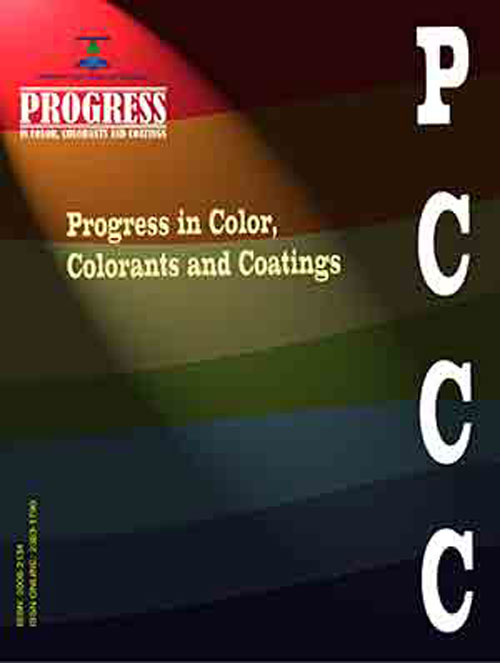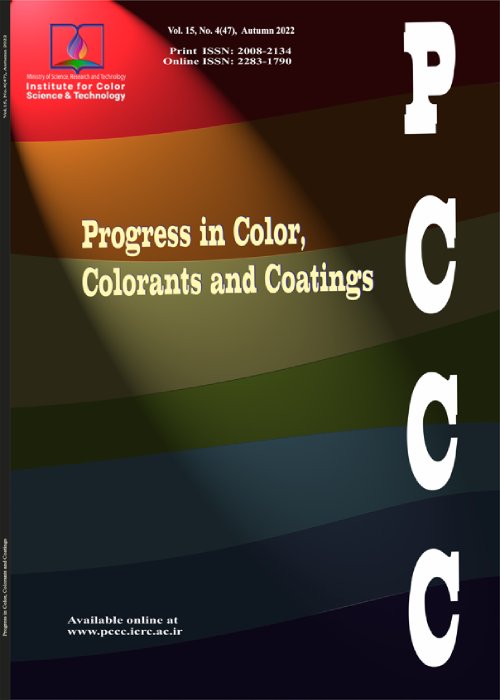فهرست مطالب

Progress in Color, Colorants and Coatings
Volume:12 Issue: 4, Autumn 2019
- تاریخ انتشار: 1398/08/10
- تعداد عناوین: 6
-
-
Pages 203-209Nickel films of 300 nm thickness were deposited by electron beam evaporation at room temperature on 316 stainless steels. Corrosion studies of Ni coated 316 SS have been performed after N+ ion implantation at different energies of 20, 40, 60 and 80 keV. The structure and surface morphology of the films were evaluated using X-ray diffraction (XRD), atomic force microscope (AFM) and scanning electron microscope (SEM). X-ray diffraction (XRD) analysis showed formation of nickel nitride phases. The corrosion behavior of the samples was evaluated by potentiodynamic polarization test in 3.5% NaCl solution. The subsequent Tafel analysis revealed nobler open circuit potential and lower corrosion current density values with increase of beam energy. By increasing the implantation energy, diffusion effect enhances, hence, larger grains with smoother surfaces are formed. The smoother surfaces show higher resistance in the corroding medium. Increase in implantation energy was beneficial in improving the corrosion resistance.Keywords: Ni Thin Films, corrosion, Potentiodynamic, Stainless steel, SEM
-
Pages 211-218This paper investigates the mixing of the graphene (GR) particles in the polyester (PE) resin by using two different dispersion techniques which are mechanical stirring and sonication method. This paper shows that the mixing method has a significant effect on the corrosive behavior of the coatings. Fourier Transform Infrared Spectroscopy (FT-IR) characterization technique is done to analyze the functional group present and evaluate the graphene/polymer matrix interaction. The FT-IR analysis has successfully done and shows that graphene has grafted onto the polyester resin. The corrosive behavior testing is evaluated by using Tafel testing and immersion test which determines the corrosive properties of the coatings based on the mixing method with three different reaction times starting from 30 minutes, 60 minutes, and lastly 90 minutes. The optimum formulation is found at 60 minutes time reaction by using sonication method. This is due to dynamic features of sonicator that have good quality for dispersion of the graphene into the polymer matrix.Keywords: corrosive properties, graphene, mechanical stirring, polyester resin, Sonication
-
Pages 219-230The dyeing of woolen yarn with eggplant peel, a natural colorant, has been studied. The main coloring component in this natural colorant is anthocyanin, which is an interesting class of dyes in the blue and red area. Eight mordants including alum, copper sulfate, ferrous sulfate, potash alum, nickel chloride, zinc sulfate, tin chloride, and potassium dichromate were used for mordanting the fibers. Four different mordanting procedures, pre-mordanting, simultaneous mordanting, a combination of pre and simultaneous mordanting and post-mordanting were used for study the effect of the mordanting procedure on color properties. Various acids such as acetic, chloric, citric, formic, lactic, nitric, oxalic, sulfuric, and tartaric were used to investigate the role of acids in dyeing. Different shades of greenish yellow to semi-blue were obtained from the dye extracted from eggplant peel. Tin chloride as a mordant produced the noticeable semi-blue color. The chromaticity values showed that sulfuric acid resulted in better navy blue hue compared to other acids for mordanted woolen yarn with tin chloride. The combination of pre and the simultaneous (or meta) mordanting procedure was found to be the efficient route for dyeing wool yarn with eggplant peel.Keywords: Color measurement, Dye characterization, Mordanting process, Natural dyeing
-
Pages 231-239Nowadays, application of cermet coatings deposited by High-Velocity Oxygen-Fuel (HVOF) has received considerable attention in a variety of industries. Carbide coatings have high surface roughness, so it is essential to grind the coated surface. The present investigation studied the effect of simultaneous changes in the grinding parameters including the depth of cut, feed rate and cutting speed on the fracture toughness of the WC-10Co-4Cr coating sprayed by HVOF. The fracture toughness was measured using the Vickers Indentation Test on the cross-sectional surface of the coating. A full factorial design of experiment was selected for experimental planning and the analysis of variance was employed to find the effect value of grinding parameters on output. The results revealed that the fracture toughness of the WC-10Co-4Cr coating increases after grinding due to the higher compressive residual stresses. The fracture toughness of coating increases with the decrease of the cutting speed and the increase of the depth of cut and feed rate. The most effective grinding parameters are depth of cut, feed rate and cutting speed, respectively. At the end of the current study, a mathematical model between grinding parameters and the fracture toughness of the coating was proposed using the regression analysis.Keywords: High-Velocity Oxygen-Fuel, Grinding, WC-10Co-4Cr, Fracture toughness, Analysis of variance
-
Pages 241-250In recent years, chitosan and its different derivatives have been extensively used in surface modification and functional finishing of textiles. In this study, wool yarns used in handmade carpet were treated with different concentrations of chitosan-poly (amidoamine) dendrimer hybrid (Ch-PAMAM) and characterized by scanning electron microscope (SEM), and their dyeing properties were investigated through dyeing with madder as natural dye. SEM images showed that Ch-PAMAM was almost evenly grafted on the wool surface which resulted in significant improvement in dyeing characteristics with madder. Indeed, treated wool exhibited lower optimal dyeing temperature and dyeing time and required lower amount of madder dye to achieve a desired color strength, as compared to raw wool. Moreover, due to its “bio-mordant” role, Ch-PAMAM was replaced with metal mordant and acid auxiliary in wool dyeing with natural dye. In addition, rub and light fastness of dyed treated wool was improved to some extent. The results of this study confirmed that Ch-PAMAM can be effectively used as alternative bio-mordant in eco-friendly dyeing of wool with madder dye.Keywords: Natural Dye, Wool yarn, dyeing, Chitosan-Dendreimer
-
Pages 251-261By introducing of digital techniques, forensic document examiners has been encouraged to work with better accuracy in non-destructive ways. The aim of this study was to present a non-destructive, accessible, economic (affordable), user friendly, portable, useful and easy technique for specifying the order of crossing lines of ink stroke and printed text. The intersections of LaserJet and Inkjet prints in different colors and brands under various handwriting pressures and papers were examined with a digital microscope. The 2414 exemplars were prepared on two types of A4 papers. For the Inkjet printer, the sequence of printed text and ink stroke cannot be recognized. For LaserJet printer, the results showed the outcomes indicated using digital microscope is a good option in defining the sequence of pen-ink strokes in different colors and black toner in most examples. In the blue, black and red hues, the sequence of print and ink is recognizable in most cases. For green color, no specific results were observed.Keywords: forensic science, document examination, Intersecting lines, digital microscope, sequence of strokes


